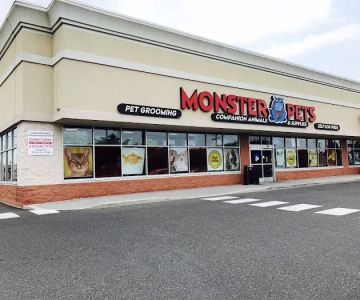How to Stop a Dog from Excessive Drooling
- 1. Introduction to Drooling in Dogs
- 2. Common Causes of Excessive Drooling
- 3. Effective Solutions for Excessive Drooling
- 4. When to See a Veterinarian
1. Introduction to Drooling in Dogs
As pet owners, we all love our dogs, but sometimes we are faced with situations that leave us wondering if something might be wrong. One common issue dog owners often encounter is excessive drooling, which can be caused by a variety of factors. While some drooling is completely normal, especially when a dog is anticipating food or chewing on something, it can sometimes indicate an underlying health issue.
If your dog has started drooling more than usual, it’s important to understand what might be causing it and what you can do to manage it. In this article, we’ll explore the common causes of excessive drooling in dogs and share effective solutions that can help reduce it. Additionally, we will look at when it's necessary to seek veterinary help.

1946 S Christopher Columbus Blvd, Philadelphia, PA 19148, USA
See Details2. Common Causes of Excessive Drooling
Excessive drooling in dogs can happen for many reasons, some of which are more serious than others. It’s important to identify the cause of the drooling to determine the best course of action. Below are some common causes:
2.1. Anxiety or Stress
Just like people, dogs can experience anxiety or stress, and it can show up as excessive drooling. Situations like car rides, visits to the vet, or loud noises can trigger stress in your dog, leading to drooling. If your dog’s drooling is linked to stressful situations, it’s essential to identify and manage those stressors.
2.2. Oral Issues
If your dog is drooling excessively, it could be a sign of oral health problems, such as gum disease, tooth decay, or an infection. Oral issues can cause pain, leading to an increase in drooling. Regular dental care and checkups are essential for preventing oral diseases in dogs.
2.3. Poisoning or Toxicity
Excessive drooling can also be a symptom of poisoning or toxicity. Dogs may accidentally ingest toxic substances such as plants, chemicals, or human foods that are harmful to them. In such cases, drooling is often accompanied by other symptoms, like vomiting, diarrhea, or lethargy. Immediate veterinary attention is required if poisoning is suspected.
2.4. Nausea or Motion Sickness
Dogs can experience motion sickness just like humans, especially during car rides. If your dog starts drooling excessively during travel, it could be a sign of nausea or motion sickness. Some dogs are more susceptible to motion sickness, particularly puppies and older dogs.
2.5. Heat Stroke or Overheating
Excessive drooling can also be a sign of heatstroke, especially in hot weather. Dogs who are exposed to extreme heat or humidity without adequate access to water or shade may drool excessively and show signs of overheating, such as panting, lethargy, or weakness. It’s crucial to keep your dog cool and hydrated, particularly during the summer months.
3. Effective Solutions for Excessive Drooling
Now that we’ve discussed some of the common causes of excessive drooling, let’s look at some solutions to help reduce the drooling and keep your dog comfortable:
3.1. Managing Anxiety and Stress
If your dog’s drooling is due to stress or anxiety, you can help by providing a calm environment. Try using calming products such as pheromone diffusers, anxiety wraps, or calming music. Training your dog to feel more comfortable with stressful situations can also be beneficial. For example, desensitizing your dog to car rides gradually can help reduce motion sickness-related drooling.
3.2. Regular Oral Care
Good dental hygiene is crucial for preventing excessive drooling caused by oral issues. Brushing your dog’s teeth regularly with dog-safe toothpaste and scheduling routine veterinary dental checkups can help prevent gum disease and tooth decay. If your dog already has dental issues, your vet may recommend professional cleanings or treatments.
3.3. Preventing Toxicity
To prevent poisoning, make sure to keep harmful substances like toxic plants, chemicals, and human foods out of reach of your dog. Always monitor your dog when they are outside and be mindful of what they might be chewing on. If you suspect your dog has ingested something toxic, contact a veterinarian immediately.
3.4. Handling Motion Sickness
If your dog experiences motion sickness, try to make car trips shorter and more comfortable. Use a dog seatbelt or crate to keep your dog secure during travel. You may also want to consult with your veterinarian for possible medications that can help with nausea or motion sickness.
3.5. Keeping Your Dog Cool
To prevent heatstroke, make sure your dog has plenty of access to fresh water and shade when outdoors. Avoid exercise during the hottest parts of the day, and never leave your dog in a hot car. If your dog shows signs of overheating, such as excessive drooling, panting, or weakness, move them to a cool area immediately and contact your vet.
4. When to See a Veterinarian
While occasional drooling is normal, excessive or persistent drooling should not be ignored. If your dog’s drooling is accompanied by other symptoms such as vomiting, lethargy, or difficulty breathing, it’s essential to seek veterinary care immediately. Additionally, if your dog’s drooling seems to be linked to a specific health issue like dental problems or poisoning, it’s best to consult with a vet as soon as possible to avoid complications.
At Hidden Brook Veterinary, we offer expert advice and treatments for all types of dog health concerns. If you’re concerned about your dog’s drooling or any other health issue, don’t hesitate to reach out for a consultation. We’re here to help you ensure your dog stays healthy and happy!









